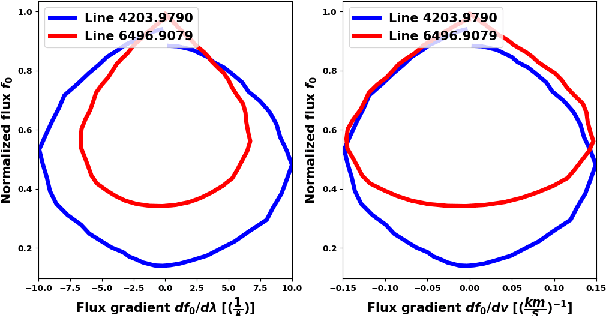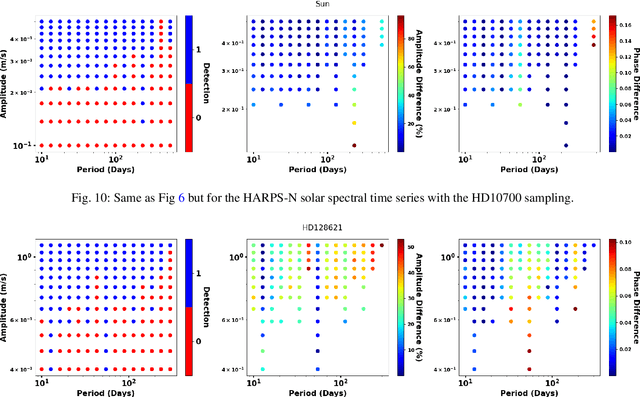Isidro Gómez-Vargas
Improving Earth-like planet detection in radial velocity using deep learning
May 21, 2024



Abstract:Many novel methods have been proposed to mitigate stellar activity for exoplanet detection as the presence of stellar activity in radial velocity (RV) measurements is the current major limitation. Unlike traditional methods that model stellar activity in the RV domain, more methods are moving in the direction of disentangling stellar activity at the spectral level. The goal of this paper is to present a novel convolutional neural network-based algorithm that efficiently models stellar activity signals at the spectral level, enhancing the detection of Earth-like planets. We trained a convolutional neural network to build the correlation between the change in the spectral line profile and the corresponding RV, full width at half maximum (FWHM) and bisector span (BIS) values derived from the classical cross-correlation function. This algorithm has been tested on three intensively observed stars: Alpha Centauri B (HD128621), Tau ceti (HD10700), and the Sun. By injecting simulated planetary signals at the spectral level, we demonstrate that our machine learning algorithm can achieve, for HD128621 and HD10700, a detection threshold of 0.5 m/s in semi-amplitude for planets with periods ranging from 10 to 300 days. This threshold would correspond to the detection of a $\sim$4$\mathrm{M}_{\oplus}$ in the habitable zone of those stars. On the HARPS-N solar dataset, our algorithm is even more efficient at mitigating stellar activity signals and can reach a threshold of 0.2 m/s, which would correspond to a 2.2$\mathrm{M}_{\oplus}$ planet on the orbit of the Earth. To the best of our knowledge, it is the first time that such low detection thresholds are reported for the Sun, but also for other stars, and therefore this highlights the efficiency of our convolutional neural network-based algorithm at mitigating stellar activity in RV measurements.
Deep Learning and genetic algorithms for cosmological Bayesian inference speed-up
May 06, 2024Abstract:In this paper, we present a novel approach to accelerate the Bayesian inference process, focusing specifically on the nested sampling algorithms. Bayesian inference plays a crucial role in cosmological parameter estimation, providing a robust framework for extracting theoretical insights from observational data. However, its computational demands can be substantial, primarily due to the need for numerous likelihood function evaluations. Our proposed method utilizes the power of deep learning, employing feedforward neural networks to approximate the likelihood function dynamically during the Bayesian inference process. Unlike traditional approaches, our method trains neural networks on-the-fly using the current set of live points as training data, without the need for pre-training. This flexibility enables adaptation to various theoretical models and datasets. We perform simple hyperparameter optimization using genetic algorithms to suggest initial neural network architectures for learning each likelihood function. Once sufficient accuracy is achieved, the neural network replaces the original likelihood function. The implementation integrates with nested sampling algorithms and has been thoroughly evaluated using both simple cosmological dark energy models and diverse observational datasets. Additionally, we explore the potential of genetic algorithms for generating initial live points within nested sampling inference, opening up new avenues for enhancing the efficiency and effectiveness of Bayesian inference methods.
 Add to Chrome
Add to Chrome Add to Firefox
Add to Firefox Add to Edge
Add to Edge